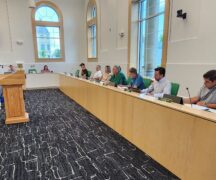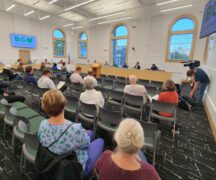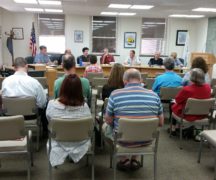By JAN LARSON McLAUGHLIN
BG Independent News
Citizens and public officials have professed their support for historic preservation in Bowling Green. During many meetings in the last 18 months about a proposed ordinance, none have spoken against the concept of saving the city’s historic buildings.
But the question is – does Bowling Green want to adopt a meaningful historic preservation ordinance?
Another meeting will be held Monday at 6 p.m. – this one for City Council’s Committee of the Whole to discuss the proposed ordinance. This will be a work session, with no public input to be heard. Due to COVID-19, the meeting will be live streamed over YouTube at www.bgohio.org/meetings.
Among the sticking points with the ordinance are the number of votes landlords get when creating historic districts, and the fairness of requiring only owners of historic homes to meet standards.
Monday’s meeting is an effort to clean up remaining questions and legal language in the ordinance, which had been tabled by City Council while public hearings were held with the city Planning Commission on the subject.
Planning Commission did not endorse the ordinance. But City Council appears to want historic preservation efforts to proceed – rather than languish because of opposition like the last time around.
“I’m under the impression that the members of City Council support historic preservation,” Council President Mark Hollenbaugh said last week during a City Council meeting.
Hollenbaugh acknowledged the changes that the Planning Commission requested in the proposed ordinance. But then said, “there’s a difference between being in support of historic prevention and being in support of meaningful historic prevention.”
There are currently 78 cities in Ohio with historic preservation ordinances – including every other university community in the state except Bowling Green.
Seven years ago, historic preservation was suggested in Bowling Green, but it failed due to opposition primarily from large landlords.
Historic preservation members voiced concern that any further watering down of the ordinance to get the support of landlords would render it useless. The board worked 18 months on fine-tuning the ordinance, according to John Sampen, chair of the Historic Preservation Commission.
In Athens, Oxford and Perrysburg, the decision for an area to become part of a historic preservation district is made by the city and property owners don’t get a vote. In Kent, owners get one vote for each property they own in a given area.
Bowling Green’s proposed ordinance would give each property owner one vote – regardless of the number of properties they own. So if a landlord owned eight homes on a block, he would just have one vote.
Sampen explained the rationale.
“We don’t give extra votes to people who are richer than others, or own more property,” he said.
The proposed BG ordinance requires a simple majority of just over 50% approval to create a district. Some landlords and members of the planning commission have suggested that the burden be higher, and that support of 60% of the landowners, 66% of the landowners, or two-thirds of the front footage be required.
Some landlords and planning commission members have suggested that inclusion in historic preservation should be voluntary.
The goal of the historic preservation plan is to help the city retain historically significant structures, to “preserve, promote, encourage and support the maintenance, use and reuse of historic buildings in the city.” It is designed to help property owners who want to preserve historic structures.
The first step is getting Certified Local Government status for the city. That would allow the community to create a plan, and make it possible for homeowners and businesses to get grants and tax credits to protect historic buildings.
Some historic homes are losing the battle against time and rental transformation. And the longer the preservation efforts are on hold, the more some structures deteriorate, commission members have said.
The plan would require property owners in designated historic areas to meet standards when making substantive changes to the exterior of buildings. There would be no rules for the interior of structures.
At last week’s City Council meeting, all the members spoke in favor of the historic preservation – and supported modifying some of the language rather than discarding the proposed ordinance.
“I’m in favor of historic presentation, and am thankful for the yeoman’s effort the Historic Preservation Commission put forth,” said council member Bill Herald. “I’m enthusiastically in favor of the concept.”
Herald pointed out that people often have to give up some freedoms when living in a municipality.
“We need to do what’s in the best interest of the community,” he said.
Council member John Zanfardino said he is opposed to watering down the proposed ordinance.
“Changing the general substance of this would be a real shame,” he said.
Council member Sandy Rowland said she wants historic preservation in Bowling Green. “But I also want all members of council to feel comfortable with it.”
“I certainly support the effort,” council member Greg Robinette said, suggesting that council just needs to clean up any ambiguity and confusing language in the ordinance.
“I think we’re close. We’re very close,” Robinette said.
Council member Rachel Phipps agreed.
“I’m super happy to support this legislation,” Phipps said, noting the value of historic preservation as an economic development tool, especially in the downtown area.
“I think we’re very close,” she said.
Council member Jeff Dennis agreed that historic preservation is a wise step for the community.
“While I sympathize with those who already maintain their properties and may feel that this ordinance is unfair, equally concerning to me is the more than $54 million in property value that Bowling Green homeowners have already lost due to deteriorating neighborhood conditions,” Dennis said.
“This is limiting our ability to attract residents and businesses, especially the young families and young professionals who want to live in the walkable neighborhoods where many of our historic homes are found,” Dennis said. “Failure to correct this will not only prevent us from attracting new residents and businesses, it will also continue to jeopardize our existing businesses. In the long term, failure to act will mean fewer jobs, higher taxes, and/or a decline in the quality of services and infrastructure the city is able to provide.”
Hollenbaugh, who was involved in the historic preservation effort in 2014, said he wants to see it put into action this time around.
“I was more than a little disappointed that it didn’t really go anywhere,” he said.
“We owe it to the (historic preservation) commission,” Zanfardino said. “This has been a seven-year issue in Bowling Green.”
During a public hearing held on the subject last week, City Council heard from some residents who own historic homes. Two members of the historic preservation commission, John Sampen and Chris Mowen, said they were proud owners of homes built more than a century ago.
Sampen said that once the character of historic buildings is gone, it is lost forever. But he added that “such a goal requires courage.”
David and Rose Drain, who own a historic home on East Court Street, said they have been making extension repairs to their home – without the proposed ordinance. David Drain said when he lived in a historic area in a different community, it took months to get plans for renovations approved.
“I do not want to live in a historic district,” he said.
“I think it’s foolish and we don’t need it,” he added.
However, Rose Drain said she is in favor of the city taking some action to address deteriorating properties – especially those owned by rental companies.
Zanfardino complimented the work done by the Drains on their home, but noted the “beat up” homes nearby.
“Not everyone takes care of properties in the same way,” Zanfardino said.
Historic Planning Commission member Les Barber said he and his wife are willing to accept the limited restrictions of the ordinance on their historic home. He also addressed Rose Drain’s concern about deteriorating rental properties – explaining that the previous ordinance dealing with that issue seven years ago was opposed by large landlords.
“What we decided to concentrate on was stopping the bleeding,” Barber said.





